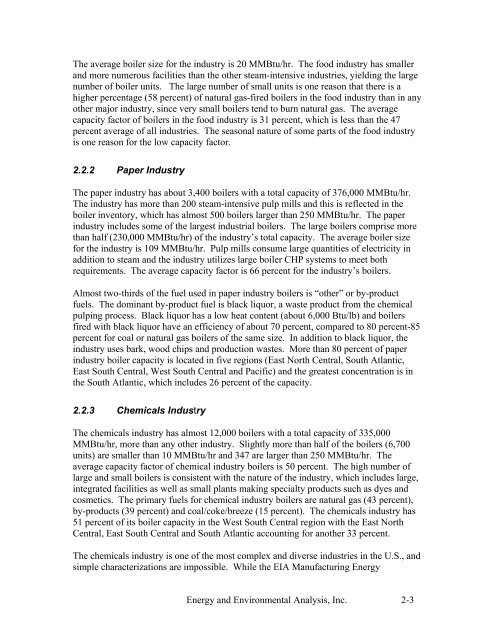Characterization of the U.S. Industrial Commercial Boiler Population
Characterization of the U.S. Industrial Commercial Boiler Population
Characterization of the U.S. Industrial Commercial Boiler Population
You also want an ePaper? Increase the reach of your titles
YUMPU automatically turns print PDFs into web optimized ePapers that Google loves.
The average boiler size for <strong>the</strong> industry is 20 MMBtu/hr. The food industry has smaller<br />
and more numerous facilities than <strong>the</strong> o<strong>the</strong>r steam-intensive industries, yielding <strong>the</strong> large<br />
number <strong>of</strong> boiler units. The large number <strong>of</strong> small units is one reason that <strong>the</strong>re is a<br />
higher percentage (58 percent) <strong>of</strong> natural gas-fired boilers in <strong>the</strong> food industry than in any<br />
o<strong>the</strong>r major industry, since very small boilers tend to burn natural gas. The average<br />
capacity factor <strong>of</strong> boilers in <strong>the</strong> food industry is 31 percent, which is less than <strong>the</strong> 47<br />
percent average <strong>of</strong> all industries. The seasonal nature <strong>of</strong> some parts <strong>of</strong> <strong>the</strong> food industry<br />
is one reason for <strong>the</strong> low capacity factor.<br />
2.2.2 Paper Industry<br />
The paper industry has about 3,400 boilers with a total capacity <strong>of</strong> 376,000 MMBtu/hr.<br />
The industry has more than 200 steam-intensive pulp mills and this is reflected in <strong>the</strong><br />
boiler inventory, which has almost 500 boilers larger than 250 MMBtu/hr. The paper<br />
industry includes some <strong>of</strong> <strong>the</strong> largest industrial boilers. The large boilers comprise more<br />
than half (230,000 MMBtu/hr) <strong>of</strong> <strong>the</strong> industry’s total capacity. The average boiler size<br />
for <strong>the</strong> industry is 109 MMBtu/hr. Pulp mills consume large quantities <strong>of</strong> electricity in<br />
addition to steam and <strong>the</strong> industry utilizes large boiler CHP systems to meet both<br />
requirements. The average capacity factor is 66 percent for <strong>the</strong> industry’s boilers.<br />
Almost two-thirds <strong>of</strong> <strong>the</strong> fuel used in paper industry boilers is “o<strong>the</strong>r” or by-product<br />
fuels. The dominant by-product fuel is black liquor, a waste product from <strong>the</strong> chemical<br />
pulping process. Black liquor has a low heat content (about 6,000 Btu/lb) and boilers<br />
fired with black liquor have an efficiency <strong>of</strong> about 70 percent, compared to 80 percent-85<br />
percent for coal or natural gas boilers <strong>of</strong> <strong>the</strong> same size. In addition to black liquor, <strong>the</strong><br />
industry uses bark, wood chips and production wastes. More than 80 percent <strong>of</strong> paper<br />
industry boiler capacity is located in five regions (East North Central, South Atlantic,<br />
East South Central, West South Central and Pacific) and <strong>the</strong> greatest concentration is in<br />
<strong>the</strong> South Atlantic, which includes 26 percent <strong>of</strong> <strong>the</strong> capacity.<br />
2.2.3 Chemicals Industry<br />
The chemicals industry has almost 12,000 boilers with a total capacity <strong>of</strong> 335,000<br />
MMBtu/hr, more than any o<strong>the</strong>r industry. Slightly more than half <strong>of</strong> <strong>the</strong> boilers (6,700<br />
units) are smaller than 10 MMBtu/hr and 347 are larger than 250 MMBtu/hr. The<br />
average capacity factor <strong>of</strong> chemical industry boilers is 50 percent. The high number <strong>of</strong><br />
large and small boilers is consistent with <strong>the</strong> nature <strong>of</strong> <strong>the</strong> industry, which includes large,<br />
integrated facilities as well as small plants making specialty products such as dyes and<br />
cosmetics. The primary fuels for chemical industry boilers are natural gas (43 percent),<br />
by-products (39 percent) and coal/coke/breeze (15 percent). The chemicals industry has<br />
51 percent <strong>of</strong> its boiler capacity in <strong>the</strong> West South Central region with <strong>the</strong> East North<br />
Central, East South Central and South Atlantic accounting for ano<strong>the</strong>r 33 percent.<br />
The chemicals industry is one <strong>of</strong> <strong>the</strong> most complex and diverse industries in <strong>the</strong> U.S., and<br />
simple characterizations are impossible. While <strong>the</strong> EIA Manufacturing Energy<br />
Energy and Environmental Analysis, Inc. 2-3
















